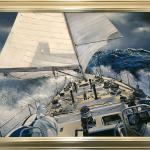SHELDON FINE ART
John D'Antonio
Born, Trenton New Jersey in 1954, John D’Antonio is considered by many in the art world as one of the leading
representational artists in America today. John was schooled at the Rhode Island School of Design, the Arts
Student’s League in New York, Lehigh University, Pennsylvania and the Hun School of Princeton. D’Antonio’s art
and philosophy have been shaped by a diverse group of influences, from Academicism to Modernism and the
Photorealist development of the 1970s.
John D’Antonio’s paintings reveal a remarkable eye for telling detail united to a virtuosic facility with composition,
color and light. D’Antonio’s work and diverse subject matter gains precision and clarity give that give his
paintings a cutting edge; high impact feel - while capturing the energy and mystery of his subject.
Early in his career he was exposed to some of the most prominent artists in modern time. Starting the Hun
School Princeton (1970), John was introduced to a classmate’s father, Roy Lichtenstein, one of the most widely
known pop artists in the world. D’Antonio immediately got a sense of how creativity and interpretation of
stereotype subjects could be used in extraordinary ways. Mr. D’Antonio then attended the Rhode Island School
of Design, (1971), where as a student, witnessed the techniques of noted graphic designer Richard Merkin,
shown in the crowd scene in Peter Blake’s design for the Sgt. Peppers Lonely Hearts Club Band album cover
(1967). It was at RISD, D’Antonio met with internationally acclaimed sculptor Louise Nevelson, pioneer of
environmental sculpture and one of the most important American sculptors of the twentieth century, who visited
with him during classroom instruction. She left a lasting impression of how scale could be used to effect of aura
of mystery that captured the public imagination for years. It was also at RISD, he painted with colleague David
Savage, grandson of Man Ray, internationally acclaimed Cubist, Dadaist, and Surrealist. After seeing a private
collection of Man Ray’s work, D’Antonio was immediately struck by the artist’s lack of concern with the traditional
and “Craft”. Man Ray is the most significant maker of camera-less photographs in the 1920s and 1930s.
D’Antonio graduated from Lehigh University in 1976. He attended the Art Students League where he studied
under Xavier Gonzales a leading instructor known for his large mural paintings; as well as mentoring past
students and friends, including Jackson Pollack and Leroy Neiman, (1980). Many of these artists had an impact
on D’Antonio’s attitude, point of view, and general philosophy regarding creativity.
